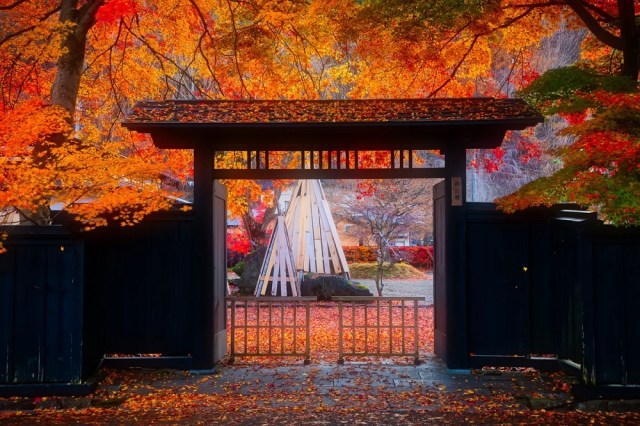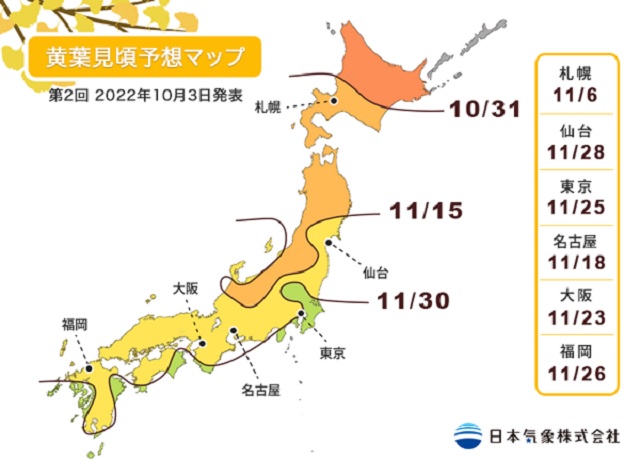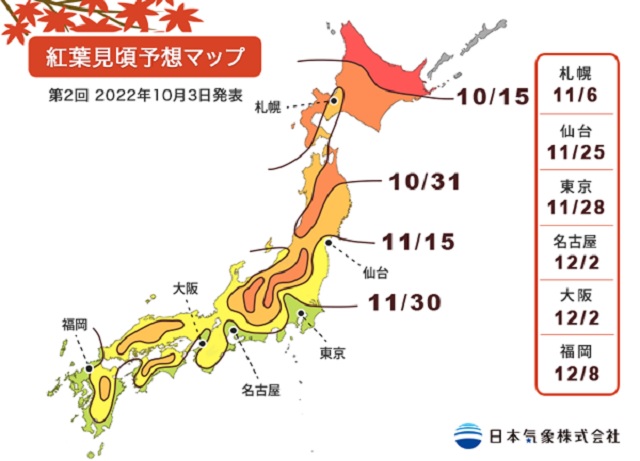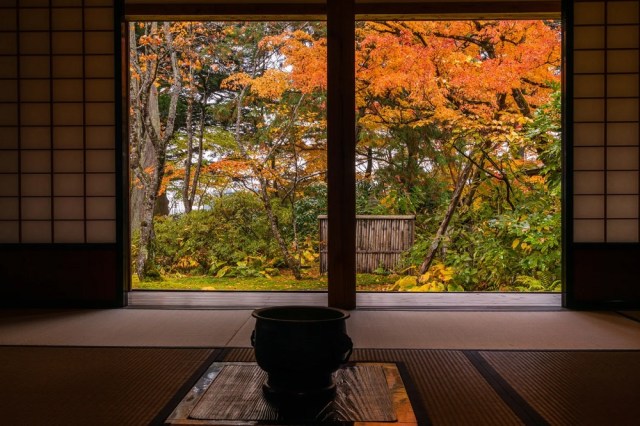
Th best part of autumn in Japan is right around the corner, and here’s the latest forecast of best koyo dates for across the country.
Japan is fully reopening to international tourism next week, and that’s especially great news for travelers since fall is one of the best times to visit Japan. Not only is it the meteorological sweet spot between the country’s humid summers and chilly winters, autumn is when Japan’s forests burst into the beautiful colors of koyo, as Japan calls the red and yellow leaves of the fall season.
However, much like with the sakura cherry blossoms of spring, planning a trip to see the fall colors in Japan is a matter of timing. Thankfully, the Japan Meteorological Corporation has just prepared its updated forecast of when the leaves will be at their most beautiful this year. The forecast focuses on the two most iconic types of koyo: maples and gingko trees (or momiji and icho, as they’re called in Japanese). Let’s start with the gingko map, since they reach their peak color earlier than the maples in most places.
While the sakura arrive first in southern Japan and work their way up north, things move in the opposite direction for koyo, as the leaves turn first in the northern, cooler parts of Japan and then progress south and west across the nation.
According to the forecast, the gingko leaves will reach their brightest yellow color in Sapporo (札幌 on the map) on November 6, Sendai (仙台) November 28, Tokyo (東京) November 25, Nagoya (名古屋) November 18, Osaka (大阪) November 23, and Fukuoka on November 26. Meanwhile, the forecast says the maples will be at their peak crimson color in Sapporo November 6, Sendai November 25, Tokyo November 28, Nagoya and Osaka (大阪) December 2, and Fukuoka December 8.
▼ The maple map
Overall, it looks like the koyo are going to be appearing a little later than usual this year, owing to the warmer-than-average fall that Japan is currently experiencing. It’s not a huge difference for most cities, but Japan Meteorological Corporation’s projected best-maple dates for Sapporo, Nagano, and Fukuoka are nine, eight, and seven days, respectively, later than average, and Fukuoka’s best-gingko date is also six days later than normal.
The forecast list of best gingko/maple dates by major city is:
● Sapporo: November 6/November 6
● Aomori: November 5/November 11
● Sendai: November 28/November 25
● Tokyo: November 25/November 28
● Kanazawa: November 11/November 28
● Nagano: November 13/November 20
● Nagoya: November 18/December 2
● Kyoto: November 26/December 9
● Osaka: November 23/December 2
● Wakayama: November 26/December 11
● Hiroshima: November 18/November 26
● Kochi: November 15/December 8
● Fukuoka: November 26/December 8
● Kagoshima; November 28/December 13
Aside from these peak-color dates, there are a few other things to keep in mind if you’re planning a koyo-seeing trip or outing. First, the higher the elevation, the earlier the leaves change color, so if you’re going to do be doing some alpine hiking, you might want to schedule it for a few days before the dates listed above. But more importantly, unlike cherry blossoms, which reach full bloom suddenly and only stick around for a few days after, the koyo season is more drawn out, lasting for about three weeks around the peak-color dates, so even if you don’t time your trip exactly, you should still be able to see some of Japan’s unforgettable fall foliage.
Source: Japan Meteorological Corporation
Top image: Pakutaso
Insert images: Japan Meteorological Corporation, Pakutaso
● Want to hear about SoraNews24’s latest articles as soon as they’re published? Follow us on Facebook and Twitter!




 Japan’s cherry blossom forecast for 2023 is here! Tokyo among cities to see sakura first
Japan’s cherry blossom forecast for 2023 is here! Tokyo among cities to see sakura first Super-detailed cherry blossom forecast maps show early arrival for Japan’s 2024 sakura season
Super-detailed cherry blossom forecast maps show early arrival for Japan’s 2024 sakura season Sakura 2017: Japan Meteorological Corporation releases first national cherry blossom forecast
Sakura 2017: Japan Meteorological Corporation releases first national cherry blossom forecast Updated cherry blossom forecast moves up blooming date, predicts sakura season start for Ueno Park
Updated cherry blossom forecast moves up blooming date, predicts sakura season start for Ueno Park Cherry blossom forecast 2018: Sakura expected to come to Tokyo earlier than usual this year!
Cherry blossom forecast 2018: Sakura expected to come to Tokyo earlier than usual this year! Japan’s new difficult-to-drink-from beer glass protects your liver, but it’s a brutal experience
Japan’s new difficult-to-drink-from beer glass protects your liver, but it’s a brutal experience How to order snacks on a Shinkansen bullet train in Japan
How to order snacks on a Shinkansen bullet train in Japan New samurai glasses are Japan’s latest weird must-have souvenir
New samurai glasses are Japan’s latest weird must-have souvenir New Pokémon ice cream, dessert drinks, and cool merch coming to Baskin-Robbins Japan【Pics】
New Pokémon ice cream, dessert drinks, and cool merch coming to Baskin-Robbins Japan【Pics】 Doraemon found buried at sea as scene from 1993 anime becomes real life【Photos】
Doraemon found buried at sea as scene from 1993 anime becomes real life【Photos】 Burger King Japan suddenly adds Dr. Pepper and Dr. Pepper floats to its menu nationwide
Burger King Japan suddenly adds Dr. Pepper and Dr. Pepper floats to its menu nationwide Starbucks Japan welcomes alpacas for cute summer drinkware line【Photos】
Starbucks Japan welcomes alpacas for cute summer drinkware line【Photos】 High-fashion Totoro cuddle purse is like an elegant stroll in the forest【Photos】
High-fashion Totoro cuddle purse is like an elegant stroll in the forest【Photos】 Studio Ghibli hair accessories keep your style tidy with help from Kiki, Moro, Calcifer, and more
Studio Ghibli hair accessories keep your style tidy with help from Kiki, Moro, Calcifer, and more What if Sailor Moon characters were lingerie models? They’d look stunning like this 【Photos】
What if Sailor Moon characters were lingerie models? They’d look stunning like this 【Photos】 Nintendo history you can feel – Super NES, N64, and GameCube controllers become capsule toys
Nintendo history you can feel – Super NES, N64, and GameCube controllers become capsule toys Hello, cosmetics! Clinique teams up with Hello Kitty this summer for first-time collaboration
Hello, cosmetics! Clinique teams up with Hello Kitty this summer for first-time collaboration Demon Slayer: Kimetsu no Yaiba gets new roller coaster attractions and food at Universal Studios Japan
Demon Slayer: Kimetsu no Yaiba gets new roller coaster attractions and food at Universal Studios Japan “The most Delicious Cup Noodle in history” – Japan’s French Cup Noodle wins our heart【Taste test】
“The most Delicious Cup Noodle in history” – Japan’s French Cup Noodle wins our heart【Taste test】 Starbucks releases a cute Frappuccino and Unicorn Cake…but not in Japan
Starbucks releases a cute Frappuccino and Unicorn Cake…but not in Japan Kyoto Tower mascot termination reveals dark side behind cute Japanese characters
Kyoto Tower mascot termination reveals dark side behind cute Japanese characters McDonald’s Japan’s Soft Twist Tower: A phantom ice cream only sold at select branches
McDonald’s Japan’s Soft Twist Tower: A phantom ice cream only sold at select branches Yabai Ramen: What makes this Japanese ramen so dangerous?
Yabai Ramen: What makes this Japanese ramen so dangerous? Finally! Nintendo Japan expands Switch 8-bit controller sales to everybody, Online member or not
Finally! Nintendo Japan expands Switch 8-bit controller sales to everybody, Online member or not Japanese government wants to build luxury resorts in all national parks for foreign tourists
Japanese government wants to build luxury resorts in all national parks for foreign tourists To combat declining birth rate, Japan to begin offering “Breeding Visas” to foreigners
To combat declining birth rate, Japan to begin offering “Breeding Visas” to foreigners 10 things you should buy at 7-Eleven in Japan
10 things you should buy at 7-Eleven in Japan Studio Ghibli releases anime heroine cosplay dresses that are super comfy to wear
Studio Ghibli releases anime heroine cosplay dresses that are super comfy to wear Woman charged for driving suitcase without a license in Osaka
Woman charged for driving suitcase without a license in Osaka Studio Ghibli unveils My Neighbour Totoro miniature house model
Studio Ghibli unveils My Neighbour Totoro miniature house model Kyoto experiencing problems with foreign tourists not paying for bus fares, but not on purpose
Kyoto experiencing problems with foreign tourists not paying for bus fares, but not on purpose Fighting mild hunger with a Japanese soda that turns into jelly in the stomach【Taste test】
Fighting mild hunger with a Japanese soda that turns into jelly in the stomach【Taste test】 Studio Ghibli’s Howl’s Moving Castle tapestry unveiled in Japan for first time
Studio Ghibli’s Howl’s Moving Castle tapestry unveiled in Japan for first time McDonald’s new Happy Meals offer up cute and practical Sanrio lifestyle goods
McDonald’s new Happy Meals offer up cute and practical Sanrio lifestyle goods Sales of Japan’s most convenient train ticket/shopping payment cards suspended indefinitely
Sales of Japan’s most convenient train ticket/shopping payment cards suspended indefinitely Sold-out Studio Ghibli desktop humidifiers are back so Totoro can help you through the dry season
Sold-out Studio Ghibli desktop humidifiers are back so Totoro can help you through the dry season Japanese government to make first change to romanization spelling rules since the 1950s
Japanese government to make first change to romanization spelling rules since the 1950s Foreigner’s request for help in Tokyo makes us sad for the state of society
Foreigner’s request for help in Tokyo makes us sad for the state of society Ghibli founders Toshio Suzuki and Hayao Miyazaki contribute to Japanese whisky Totoro label design
Ghibli founders Toshio Suzuki and Hayao Miyazaki contribute to Japanese whisky Totoro label design Tokyo’s most famous Starbucks is closed
Tokyo’s most famous Starbucks is closed Princesses, fruits, and blacksmiths: Study reveals the 30 most unusual family names in Japan
Princesses, fruits, and blacksmiths: Study reveals the 30 most unusual family names in Japan Cherry blossom forecast 2020 released! Sakura season shifts to new start time in Tokyo this year
Cherry blossom forecast 2020 released! Sakura season shifts to new start time in Tokyo this year Heavy snowfall comes early to Japan, creates beautiful images of snow-covered autumn leaves【Pics】
Heavy snowfall comes early to Japan, creates beautiful images of snow-covered autumn leaves【Pics】 Kyoto’s Rurikoin Temple to offer stunning views of autumn leaves for a limited time next month
Kyoto’s Rurikoin Temple to offer stunning views of autumn leaves for a limited time next month Cherry blossoms begin blooming in Tokyo, earliest start to sakura season for third year
Cherry blossoms begin blooming in Tokyo, earliest start to sakura season for third year Sakura season officially declared in Tokyo, earliest start to hanami on record
Sakura season officially declared in Tokyo, earliest start to hanami on record 10 gorgeous, must-visit places to see the autumn leaves in Japan
10 gorgeous, must-visit places to see the autumn leaves in Japan Sakura season officially starts in Tokyo as cherry blossoms begin blooming in the capital
Sakura season officially starts in Tokyo as cherry blossoms begin blooming in the capital Tokyo’s best downtown garden gets even more beautiful with after-dark fall colors event
Tokyo’s best downtown garden gets even more beautiful with after-dark fall colors event Sakura report 2019: First cherry blossoms begin to bloom in Tokyo
Sakura report 2019: First cherry blossoms begin to bloom in Tokyo Sakura season 2018 officially declared in Tokyo as first cherry blossoms begin to bloom
Sakura season 2018 officially declared in Tokyo as first cherry blossoms begin to bloom Snow Sakura in Japan: A magical hanami cherry blossom viewing experience【Pics & Video】
Snow Sakura in Japan: A magical hanami cherry blossom viewing experience【Pics & Video】 Think you’ve had every type of tempura? Not until you’ve eaten deep-fried maple leaves
Think you’ve had every type of tempura? Not until you’ve eaten deep-fried maple leaves Rainy day in Kyoto creates amazing photo of sakura above, below, and all around
Rainy day in Kyoto creates amazing photo of sakura above, below, and all around This amazing photo of the Japan Alps only gets more beautiful the higher you look
This amazing photo of the Japan Alps only gets more beautiful the higher you look Sakura forecast 2022 released! Cherry blossoms set to bloom even earlier in Japan this year
Sakura forecast 2022 released! Cherry blossoms set to bloom even earlier in Japan this year Krispy Kreme’s new sakura donut is available at only one place in all of Japan
Krispy Kreme’s new sakura donut is available at only one place in all of Japan
Leave a Reply